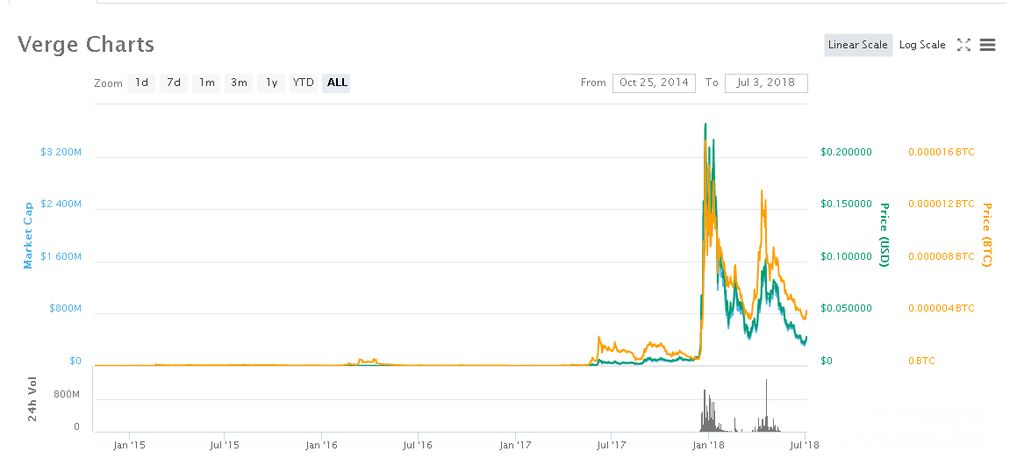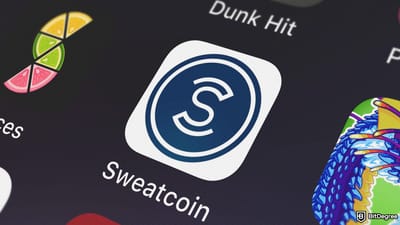Stop overpaying - start transferring money with Ogvio. Sign up, invite friends & grab Rewards now! 🎁
Hello and welcome to this Verge VS Monero guide. I’ve put it together to introduce some of the fundamental concepts about these two interesting, privacy-focused cryptocurrencies.
In this Monero VS Verge coin comparison, I’ll cover the basics of Verge VS Monero, and how each of these cryptocurrencies achieves privacy. I'll explain the reasons why privacy-focused currencies might be important, and why each of these currencies has been adopted for different uses.
We'll then discuss the speed of both the Monero and Verge blockchains, and how each currency plans to scale to meet potential future demand. We'll cover the teams behind each of the projects, the history behind them and also some market price analysis.
So, by the end of this Verge VS Monero coin review, you’ll have a much better understanding of both Monero and Verge. You should then be able to tell which you would want to use or invest in. Also, if you do decide to invest, make sure to do so via a reliable exchange platforms - Binance, Kraken, Coinbase, and Kucoin are a few popular picks.
There are loads to get through in this Verge VS Monero guide, so let’s begin already!

Did you know?
Subscribe - We publish new crypto explainer videos every week!
What is a Rug Pull in Crypto? (Meaning + Examples)


Table of Contents
- 1. Monero VS Verge: The Basics
- 1.1. Monero
- 1.2. Verge
- 2. Privacy in Verge VS Monero
- 2.1. Why Go Anonymous Anyway?
- 3. Adoption
- 3.1. Monero
- 3.2. Verge
- 4. Speed
- 5. Scalability
- 5.1. Monero
- 5.2. Verge
- 6. Monero VS Verge: The Teams
- 6.1. The Monero Team
- 6.2. The Verge Team
- 7. Verge VS Monero: Market History to Date
- 7.1. Monero
- 7.2. Verge
- 8. Verge VS Monero Comparison Chart
- 9. Verge VS Monero: The Conclusion
Monero VS Verge: The Basics
Monero
Monero was created in 2014. The first version of the currency was called BitMonero. However, this was shortened to simply Monero early on.
Monero uses the same code base as another cryptocurrency called Bytecoin. However, there are a few differences. The original decision was made to fork Monero from Bytecoin because of some controversy surrounding the original distribution of Bytecoin. It was discovered that around 80% of the total supply of Bytecoin had already been mined when it was launched. Many in the cryptocurrency community disagreed with this. Therefore, it was decided to fork Bytecoin to form Monero.
Unlike Bitcoin, Monero uses the CryptoNote protocol. CryptoNote is a different mining algorithm for Bitcoin’s SHA-256 algorithm. Don’t worry if you don’t know what these are, it’s not important to have a good knowledge of these terms to be able to use Monero!
Like Bitcoin, Monero is a Proof-of-Work cryptocurrency. This means that computational power is needed to verify transactions on the network. The computer systems providing this power are known as miners. However, unlike Bitcoin, it’s still possible to mine Monero using regular computers (with a CPU) or high-end gaming machines (using a GPU). To learn more about Monero, follow my guide here.

Did you know?
Subscribe - We publish new crypto explainer videos every week!
What is Olympus DAO? (OHM Crypto Animated Explainer)



- Secure and reliable
- Accepts fiat currencies
- Lots of trading options
- Reputable exchange
- Accepts fiat currencies
- Offers various trading options

- Huge trading variety
- Regulation-compliant around the globe
- Fair trading fees
- Beginner-friendly
- A wide array of features
- Vast number of different crypto coins & tokens

- Beginner-friendly
- Secure
- Decent trading and withdrawal fees
- Crypto.com Visa Card
- Automated tools & bots
- Ecosystem synergy with CRO
Verge
Verge was first launched in 2014. It’s a decentralized and open-source cryptocurrency. Like Monero, its purpose is to provide private transactions for its users. It was originally called DogeCoinDark. However, it changed the name to Verge in 2016. Verge shares a lot of the same coding as Dogecoin. However, the development team claims that it is not based on the original “meme-coin”. There is a lot of dispute within the cryptocurrency community about this.
There is a massive maximum supply of 16.5 billion Verge coins that will ever be mined. This is considerably more than many other cryptocurrency projects. That’s why the price is so low and has never reached even a single dollar.
Like Monero, Verge is a proof-of-work coin. However, it uses five different mining algorithms. The idea behind this is to increase decentralization on the network. By using so many different algorithms, many different units can successfully mine Verge. The more miners there are on a blockchain, the more secure it should be! Curious to learn more about Verge? See my guide here.
Privacy in Verge VS Monero
Verge VS Monero, which is the most private? Well, both achieve their privacy in different ways.
For its privacy, Monero uses a combination of cryptographic protocols. These are called ring signatures and the CryptoNote algorithm. Now, unless you’re good at programming, you’re going to struggle to understand exactly how each of these works. Don’t worry, instead of confusing the pants off you, I’ll simplify it for you.
The Monero network essentially groups transactions. It then sends the correct amount of Monero to receiving addresses from this group. This means that no one can tell exactly who sent what to who.
Meanwhile, the Verge’s privacy is achieved in a completely different way. It has two different ledgers: a public one and a private one. Transactions made using the public ledger are visible for anyone to see.
However, the tool that makes it possible to browse the dark web in secret (Tor), along with an anonymous network layer, hides the IP addresses and locations of those who make transactions. This is how the Verge’s private ledger works. It behaves more like Monero’s in that no one can see any of the transactions occurring on it.
Why Go Anonymous Anyway?
There are many reasons why someone would want to transact anonymously. Some of them are morally questionable and others less so. Let’s look at the most common:
Firstly, there is the dark web use case that Bitcoin became famous for in its early existence. However, not all the people that use the dark web do so to buy substances and items to use for self-serving reasons. For example, people who live in parts of the world where medicinal cannabis is illegal can use the dark web to get access to life-saving treatments.
In the UK, high strength CBD oil used to treat cancers, epilepsy, and a range of other conditions is almost impossible to get hold of. However, thanks to the dark web, patients can self-medicate, and parents of sick children have a chance to treat their kids without having to meet dangerous dealers in the streets.
Another use case that is emerging for anonymous cryptocurrencies is cybercrime. One attack that uses anonymous payments is ransomware. Ransomware involves encrypting the data on a computer system. This is done with a piece of software downloaded onto the system. The attacker requests payment be made to unencrypt the data. Of course, if you can take payment in an anonymous currency, your chances of being caught performing such a criminal act are lower.
A very different use for private currencies involves people of certain lifestyles or sexualities. If they were born in some nations, the punishments for being gay, for example, might be severe. This could make a person want to flee the country or seek services to meet people in similar situations. With the penalties being so stiff, it’s understandable that they might want to pay for such services using an anonymous currency.
Adoption
Now that I’ve explained some of the reasons why someone might want to use an anonymous currency in the first place, it’s the time in this Verge VS Monero guide to looking at how each of these currencies is currently being adopted. Interestingly, despite their similar properties, Monero and Verge’s adoption have been rather different from one another.
Monero
The first and most obvious use case of Monero is on the dark web. Of the many different anonymous cryptocurrencies, Verge included, Monero seems to be the one most used on the dark web. It is quickly taking over Bitcoin as the currency of choice on various hidden marketplaces.
Another use case that Monero has found is to evade economic sanctions imposed on certain countries by others. The likes of North Korea have previously hacked various cryptocurrency exchanges. They then convert the stolen money into Monero.
This means that it can be moved around and used to pay for goods and services on global black markets. By moving money using an anonymous currency, it’s impossible for the US and other world powers to limit their activity by denying financial services or trading with them.
Monero also seems to be becoming the preferred currency for those wishing to perform the kind of attacks that I mentioned in the previous section. Those behind such cybercriminal acts are moving quickly from Bitcoin to Monero thanks to its enhanced privacy functions.
In-Browser Mining and Crypto-Jacking
A final use case that Monero has found can be both a positive and a negative one. Since Monero can be easily mined using both CPUs and GPUs, it has become a clear choice for what is known as in-browser mining.
In-browser mining is cryptocurrency mining that is done from within a user’s internet browser. The first reason for in-browser mining is to make money. It’s not very efficient but a user can launch in-browser mining software to earn small amounts of cryptocurrency whilst they browse.
In-browser mining can also be used to monetize a webpage instead of using adverts. Somewhere in the page, it will usually say that some of your computer’s resources are being borrowed by the site to mine Monero for the publisher. Alternatively, this can also be done without the user’s permission. When this is the case, it is a form of “crypto-jacking”. Crypto-jacking can also be done by installing malicious software on a computer system to mine Monero or other cryptocurrencies when the user is not visiting a specific website.
Finally, in-browser mining can also be used for charitable reasons. Children’s charity UNICEF has launched a website called The Hopepage. The idea behind The Hopepage is to let users donate some of their computing power to mining cryptocurrency whilst they browse. There are options to donate between 20% and 80% of the visitor’s computer power. At the time of writing, there were almost 18,500 people donating computing power to the charity!

Did you know?
Subscribe - We publish new crypto explainer videos every week!
What is Olympus DAO? (OHM Crypto Animated Explainer)



- Secure and reliable
- Accepts fiat currencies
- Lots of trading options
- Reputable exchange
- Accepts fiat currencies
- Offers various trading options

- Huge trading variety
- Regulation-compliant around the globe
- Fair trading fees
- Beginner-friendly
- A wide array of features
- Vast number of different crypto coins & tokens

- Beginner-friendly
- Secure
- Decent trading and withdrawal fees
- Crypto.com Visa Card
- Automated tools & bots
- Ecosystem synergy with CRO
Verge
Verge’s adoption seems to be slower but somewhat more positive than that of Monero’s. There are fewer cybercriminals and rogue states currently using the currency for one thing!
One recent development that had the Verge community excited was the signing of a partnership with the parent company (MindGeek) of the planet’s leading pornography website, PornHub. The “YouTube of porn” started accepting the currency for payment for any of their premium features in April of 2018. Also, two of the site’s sister pages (Brazzers and Nutaku) now accept the Verge for payments.
The team behind MindGeek and PornHub said they favored Verge because of its anonymous features. Not everyone wants to make it public that they’re looking at pornographic material so for PornHub, it made sense to use Verge rather than Bitcoin or Ethereum, for example.
Another partnership that Verge has managed to secure is with Token Pay. Token Pay is a firm with its cryptocurrency that is looking to make cryptocurrency payment cards. Along with their partnership with Verge, Token Pay has also partnered with WEG Bank AG from Germany.
The partnerships with MindGeek and Token Pay are potentially very exciting for the Verge project. This is because there could be an influx of people who learn about cryptocurrency and Verge specifically thanks to them using PornHub, Token Pay, or the WEG Bank AG.
Speed
The Monero blockchain has a block time of two minutes. This means that new blocks of transactions are formed once every 120 seconds. This makes it about five times faster to transact with than Bitcoin.
Meanwhile, Verge has a block time of 30 seconds. This makes it considerably faster to transact with than Bitcoin and around four times faster than Monero.
The figures quoted above presume that transactions can fit in the next block. If either network is congested with a lot of transactions, the time it takes to send Monero or Verge will be longer.
Scalability
Let's take a look at Verge VS Monero scalability.
Monero
Monero uses what is called a dynamic block size limit. This means that the blocks grow and shrink as demand for Monero increases or decreases. Larger blocks can fit more transactions in them so that more people can use the Monero network at the same time. However, since the network is yet to achieve the same popularity as the Bitcoin, it is unclear how this scalability solution will work in practice.

Did you know?
Subscribe - We publish new crypto explainer videos every week!
What is Olympus DAO? (OHM Crypto Animated Explainer)



- Secure and reliable
- Accepts fiat currencies
- Lots of trading options
- Reputable exchange
- Accepts fiat currencies
- Offers various trading options

- Huge trading variety
- Regulation-compliant around the globe
- Fair trading fees
- Beginner-friendly
- A wide array of features
- Vast number of different crypto coins & tokens

- Beginner-friendly
- Secure
- Decent trading and withdrawal fees
- Crypto.com Visa Card
- Automated tools & bots
- Ecosystem synergy with CRO
Verge
The team behind Verge claims that it is much more scalable than Bitcoin. They are currently working on adding RSK (rootstock) to Verge. Rootstock is a second layer protocol that is also being designed to work with Bitcoin. It is believed that this will make the network be able to handle around 2,000 transactions per second.
This is a considerable increase from the current maximum of 100 transactions per second. Rootstock will also allow developers to create smart contract-based applications like those on the Ethereum network.
Monero VS Verge: The Teams
It’s always good to compare the teams when looking at different cryptocurrency projects. However, since anonymity is the goal of both the Verge and Monero projects, the teams are largely kept a secret. Yet, let's look who has the better team in Verge VS Monero comparison.
The Monero Team
Only two of the lead developers behind the Monero project are known by their real names. These are Riccardo “fluffypony” Spagni and Francisco “ArticMine” Cabañas. Spagni is the most vocal of the developers and is very active on Twitter under the handle @fluffypony. He has many years’ experience as a software developer and has an education in logistics and informatics.

Joining Spagni and Cabañas is a long list of developers who prefer to go by aliases. Since little is known about the team, I’ll have to cut this section short!
The Verge Team
Slightly more is known about the Verge team. However, like those working on Monero, many of these developers prefer to go by aliases. Despite this, there is more information published about the members.
The founder of Verge uses the alias Sunerok. He has over 20 years’ experience in network security and has worked on blockchain development for over six years.
Sunerok is joined by Sasha. Sasha holds a master’s degree in economics and a bachelor’s degree in business administration. He also freelances as a data scientist.
Verge’s marketing department is headed by Kieran Daniels. Daniels has previously worked at Instapage.com, as well as founding Dextroid.io and CryptoAnswer.com.
Verge VS Monero: Market History to Date
Next, in this Verge VS Monero guide, I’ll look at the market history of both projects. Like most cryptocurrencies, they follow similar trends. However, certain news events also impacted on the price of each of the currencies.
Monero
In Monero’s early years, the price didn’t see any great moves in either direction. This changed towards the end of 2016 when the entire cryptocurrency market began to see an uptrend. As 2016 turned into 2017, this upwards movement got faster. By the middle of 2017, Monero, like many other digital assets, experienced explosive growth.
The price of a single Monero coin peaked at around $500 per coin in January of 2018. Since its high point, the price has experienced a downtrend. This is consistent with the rest of the market. Apart from a few jumps in price, Monero’s price has slowly declined to the point it is at today (July 3, 2018) of around $137.
You can see the entire market history of Monero below.


Did you know?
Subscribe - We publish new crypto explainer videos every week!
What is Olympus DAO? (OHM Crypto Animated Explainer)



- Secure and reliable
- Accepts fiat currencies
- Lots of trading options
- Reputable exchange
- Accepts fiat currencies
- Offers various trading options

- Huge trading variety
- Regulation-compliant around the globe
- Fair trading fees
- Beginner-friendly
- A wide array of features
- Vast number of different crypto coins & tokens

- Beginner-friendly
- Secure
- Decent trading and withdrawal fees
- Crypto.com Visa Card
- Automated tools & bots
- Ecosystem synergy with CRO
Verge
Verge’s story is like that of Monero. However, it took slightly longer for the Verge to start its uptrend. For much of its early life, Verge cost just fractions of a cent. There was a brief period of optimism in spring 2016 but this quietened down quickly, and the largely flat line continued.
It would be a whole year later, on April 2017, that the cryptocurrency community noticed Verge properly. The price experienced an uptrend that would continue throughout 2017. It reached a high of just over 28c in December 2017. Unfortunately, since then it has largely been trending downwards to its price today of over 0.023c. However, like Monero, there have been periods during 2018 that the price bounced up again. The announcement of the MindGeek partnership was the cause of one of these uptrends.
You can see the entire history of the Verge’s price movements in the graph below.

Verge VS Monero Comparison Chart
| Founded | Total end supply | Total units at the time of writing | Current price in USD | All-time high in USD | Block time | Mining | Transactions per second | |
| Monero | 2014 | 18,400,000 (+ 0.3 XMR/minute) | 16,180,000 | $138.13 | $494 | 2 minutes | GPU/CPU | Theoretically unlimited |
| Verge | 2014 | 16.5 billion | 15.05 billion | $0.026125 | $0.28 | 30 seconds | GPU/CPU | 100 |
Verge VS Monero: The Conclusion
So, that’s it! This Verge VS Monero guide is all done. Did you learn a lot? I hope so!
These are just two of the many different privacy-focused cryptocurrency projects around today. Many different teams of developers are trying their best to become the go-to privacy-focused coin for use when making potentially sensitive transactions.
One thing to beware of is the legality of such coins. Already in Japan, the authorities are trying to stamp out the use of anonymous cryptocurrencies such as Verge and Monero. Whilst it would be very difficult for global authorities to do this entirely, such a crackdown would be very bad for the long-term price prospects of privacy-focused cryptocurrencies. This is something to be aware of if you’re planning on investing in such coins.
|
|
|
|
|---|---|---|
|
|
|
|
|
|
|
|
|
|
| Supported ✅ | Not Supported ❌ | |
| Visit site Read review | See TOP10 Brands Read review |
Table: The main pros and cons of the Binance and Kraken crypto exchange platforms
That said, there are plenty of legal uses of private currencies. Not everyone is comfortable with the government knowing their spending habits down to the last cent, for example. Then, some uses are illegal in one piece of land, and completely legal over a border. In a world where ideas (and now - money) can move around the globe in seconds, this seems completely ridiculous to deny certain potential medicines based on the location you were born in.
There are lots of good reasons for privacy coins to exist. So, now that we’re all done, what do you think? What would you like to use a private currency for? We’d love to hear your thoughts! On top of that, don't forget to check out Binance, Kraken, as well as other top-rated exchanges - there are multiple high-end options to pick from, when it comes to buying either Monero or Verge!
The content published on this website is not aimed to give any kind of financial, investment, trading, or any other form of advice. BitDegree.org does not endorse or suggest you to buy, sell or hold any kind of cryptocurrency. Before making financial investment decisions, do consult your financial advisor.









